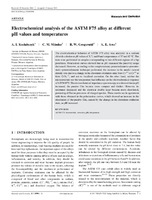| dc.creator | Kociubczyk, Alex Iván | |
| dc.creator | Méndez, Claudia Marcela | |
| dc.creator | Gregorutti, Ricardo Walter | |
| dc.creator | Ares, Alicia Esther | |
| dc.date.accessioned | 2023-01-30T12:37:00Z | |
| dc.date.available | 2023-01-30T12:37:00Z | |
| dc.date.issued | 2017-02-27 | |
| dc.identifier.citation | Kociubczyk, A. I., Méndez, C. M., Gregorutti, R. W., y Ares, A. E. (2017). Electrochemical analysis of the ASTM F75 alloy at different pH values and temperatures. Materials and Corrosion. Weinheim, Alemania : Wiley; 68(9), pp. 1-11. | es_AR |
| dc.identifier.issn | 1521-4176 | |
| dc.identifier.other | CCPI-CNyE-A-124 | |
| dc.identifier.other | 8993 | |
| dc.identifier.uri | https://hdl.handle.net/20.500.12219/4437 | |
| dc.description | Fil: Kociubczyk, Alex Iván. Consejo Nacional de Investigaciones Científicas y Técnicas. Centro Científico Tecnológico (Nordeste). Instituto de Materiales de Misiones; Argentina. | es_AR |
| dc.description | Fil: Kociubczyk, Alex Iván. Universidad Nacional de Misiones. Facultad de Ciencias Exactas, Químicas y Naturales. Instituto de Materiales de Misiones; Argentina. | es_AR |
| dc.description | Fil: Méndez, Claudia Marcela. Universidad Nacional de Misiones. Facultad de Ciencias Exactas, Químicas y Naturales; Argentina. | es_AR |
| dc.description | Fil: Gregorutti, Ricardo Walter. Comisión de Investigaciones científicas (Buenos Aires). Laboratorio de Entrenamiento Multidisciplinario para la Investigación Tecnológica; Argentina. | es_AR |
| dc.description | Fil: Ares, Alicia Esther. Consejo Nacional de Investigaciones Científicas y Técnicas. Centro Científico Tecnológico (Nordeste). Instituto de Materiales de Misiones; Argentina. | es_AR |
| dc.description | Fil: Ares, Alicia Esther. Universidad Nacional de Misiones. Facultad de Ciencias Exactas, Químicas y Naturales. Instituto de Materiales de Misiones; Argentina. | es_AR |
| dc.description.abstract | The electrochemical behavior of ASTM F75 alloy was analyzed in a sodium chloride solution at pH values of 5, 7, and 9 and temperatures of 37 and 42 °C. The tests were performed in samples corresponding to two different regions of a hip prosthesis. Polarization curves showed that as pH increased the passivity range decreased. However, according to the complementary potentiodynamic–potentiostatic–potentiodynamic technique performed, the increase in the anodic current density was due to a change in the chromium oxidation state from Cr+3 to Cr+6 to form CrO4−2, and not to localized corrosion. On the other hand, neither the microstructure nor the temperature had influence on the electrochemical response of ASTM F75. The electrochemical impedance spectroscopy test showed that as pH increased, the passive film became more compact and thicker. However, its resistance decreased and the electrical double layer became more disordered, promoting diffusion processes of charged species. These results are in agreement with those obtained in the polarization curves, which showed an increase in the dissolution of the passive film, caused by the change in the chromium oxidation state, as pH increased. | en |
| dc.format | application/pdf | |
| dc.format.extent | 1.074 MB | |
| dc.language.iso | eng | en |
| dc.publisher | Wiley | en |
| dc.relation | info:eu-repo/semantics/altIdentifier/urn/https://onlinelibrary.wiley.com/doi/abs/10.1002/maco.201609394 | |
| dc.rights | CC0 1.0 Universal | |
| dc.rights | info:eu-repo/semantics/openAccess | |
| dc.rights.uri | http://creativecommons.org/publicdomain/zero/1.0/ | |
| dc.subject | Astm F75 | en |
| dc.subject | Biomaterials | en |
| dc.subject | Corrosion | en |
| dc.subject | Ph | en |
| dc.subject | Temperature | en |
| dc.title | Electrochemical analysis of the ASTM F75 alloy at different pH values and temperatures | en |
| dc.type | info:eu-repo/semantics/article | |
| dc.type | info:ar-repo/semantics/artículo | |
| dc.type | info:eu-repo/semantics/publishedVersion | |




